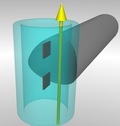Transepidermal water loss
Transepidermal Water Loss (TEWL) is a critical parameter in the study of skin physiology, indicating the amount of water that passes from inside the body through the epidermis to the external environment. TEWL is an essential factor in understanding the barrier function of the skin, which is vital for maintaining skin hydration, elasticity, and overall health. This process is not only crucial for the field of dermatology but also has significant implications in cosmetology and skin care product development.
Overview[edit]
The epidermis, the outermost layer of the skin, serves as the primary barrier against environmental stressors, including pathogens, chemicals, and physical injuries. One of its key functions is to regulate water content, both retaining moisture within the body and preventing excessive water loss. TEWL is a measure of the efficacy of the skin's barrier function, with higher rates of TEWL indicating a compromised barrier and, consequently, drier and more vulnerable skin.
Measurement of TEWL[edit]
TEWL is measured using specialized instruments that analyze the water gradient and evaporation rate on the skin's surface. These devices, often referred to as TEWL meters, provide valuable data for researchers and clinicians in assessing skin barrier health. The measurement of TEWL is crucial in diagnosing and managing various skin conditions, including eczema, psoriasis, and contact dermatitis, where the skin barrier is often compromised.
Factors Affecting TEWL[edit]
Several factors can influence TEWL, including environmental conditions (such as humidity and temperature), age, skin diseases, and the use of skin care products. For instance, low humidity and cold temperatures can increase TEWL, leading to dry and cracked skin. Conversely, optimal humidity and temperature can help maintain a healthy skin barrier and minimize water loss.
Clinical and Cosmetic Implications[edit]
Understanding and managing TEWL is vital in both clinical and cosmetic dermatology. In clinical settings, measuring TEWL can help diagnose skin barrier disorders and evaluate the effectiveness of treatments. In the cosmetic industry, reducing TEWL is a primary goal for many skin care products, aiming to enhance skin hydration and appearance. Ingredients such as humectants, emollients, and occlusives are commonly used in formulations to reduce TEWL and improve skin health.
Conclusion[edit]
Transepidermal water loss is a fundamental concept in understanding skin health and function. By measuring and managing TEWL, individuals can significantly impact their skin's appearance, health, and overall well-being. As research in this area continues to evolve, new strategies and products are likely to emerge, further enhancing our ability to maintain healthy and resilient skin.
-
Tewameter Principle
Ad. Transform your life with W8MD's Budget GLP-1 injections from $75


W8MD offers a medical weight loss program to lose weight in Philadelphia. Our physician-supervised medical weight loss provides:
- Weight loss injections in NYC (generic and brand names):
- Zepbound / Mounjaro, Wegovy / Ozempic, Saxenda
- Most insurances accepted or discounted self-pay rates. We will obtain insurance prior authorizations if needed.
- Generic GLP1 weight loss injections from $75 for the starting dose.
- Also offer prescription weight loss medications including Phentermine, Qsymia, Diethylpropion, Contrave etc.
NYC weight loss doctor appointmentsNYC weight loss doctor appointments
Start your NYC weight loss journey today at our NYC medical weight loss and Philadelphia medical weight loss clinics.
- Call 718-946-5500 to lose weight in NYC or for medical weight loss in Philadelphia 215-676-2334.
- Tags:NYC medical weight loss, Philadelphia lose weight Zepbound NYC, Budget GLP1 weight loss injections, Wegovy Philadelphia, Wegovy NYC, Philadelphia medical weight loss, Brookly weight loss and Wegovy NYC
|
WikiMD's Wellness Encyclopedia |
| Let Food Be Thy Medicine Medicine Thy Food - Hippocrates |
Medical Disclaimer: WikiMD is not a substitute for professional medical advice. The information on WikiMD is provided as an information resource only, may be incorrect, outdated or misleading, and is not to be used or relied on for any diagnostic or treatment purposes. Please consult your health care provider before making any healthcare decisions or for guidance about a specific medical condition. WikiMD expressly disclaims responsibility, and shall have no liability, for any damages, loss, injury, or liability whatsoever suffered as a result of your reliance on the information contained in this site. By visiting this site you agree to the foregoing terms and conditions, which may from time to time be changed or supplemented by WikiMD. If you do not agree to the foregoing terms and conditions, you should not enter or use this site. See full disclaimer.
Credits:Most images are courtesy of Wikimedia commons, and templates, categories Wikipedia, licensed under CC BY SA or similar.
Translate this page: - East Asian
中文,
日本,
한국어,
South Asian
हिन्दी,
தமிழ்,
తెలుగు,
Urdu,
ಕನ್ನಡ,
Southeast Asian
Indonesian,
Vietnamese,
Thai,
မြန်မာဘာသာ,
বাংলা
European
español,
Deutsch,
français,
Greek,
português do Brasil,
polski,
română,
русский,
Nederlands,
norsk,
svenska,
suomi,
Italian
Middle Eastern & African
عربى,
Turkish,
Persian,
Hebrew,
Afrikaans,
isiZulu,
Kiswahili,
Other
Bulgarian,
Hungarian,
Czech,
Swedish,
മലയാളം,
मराठी,
ਪੰਜਾਬੀ,
ગુજરાતી,
Portuguese,
Ukrainian

